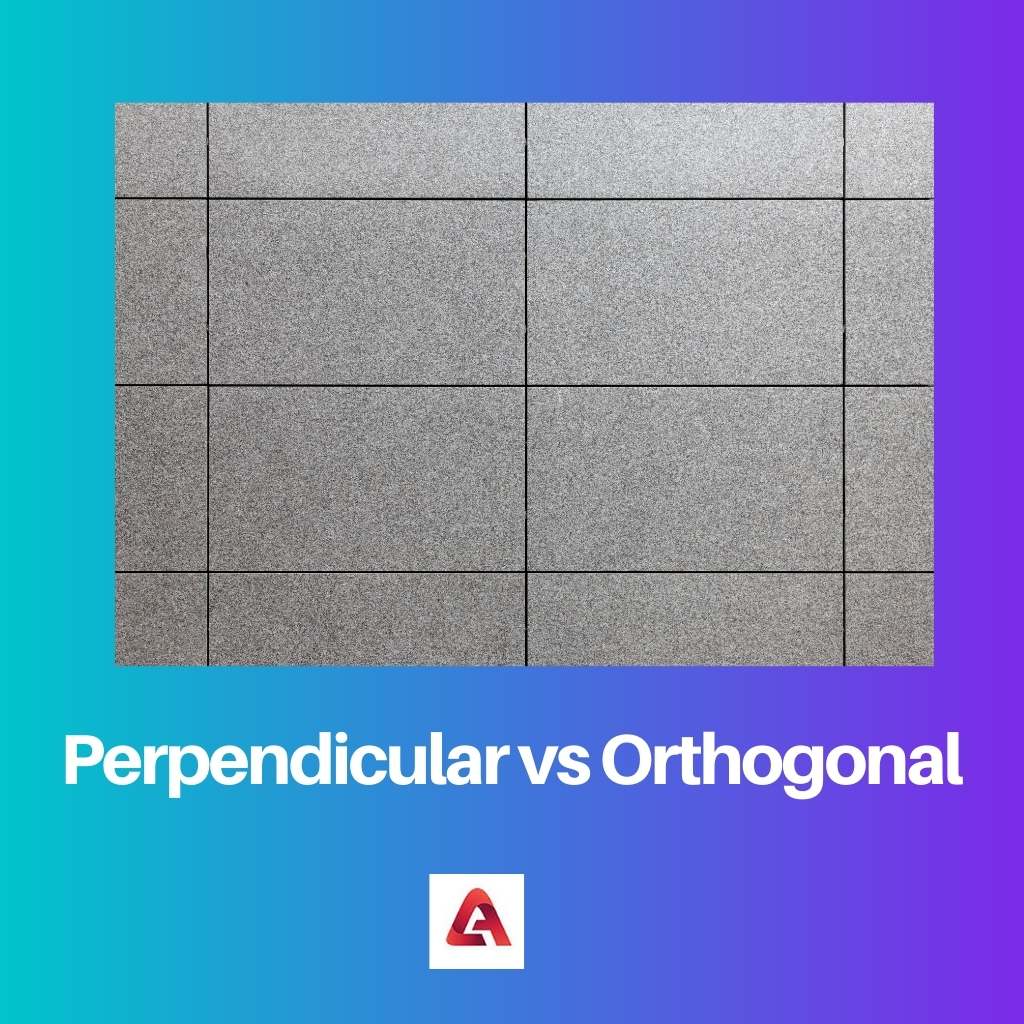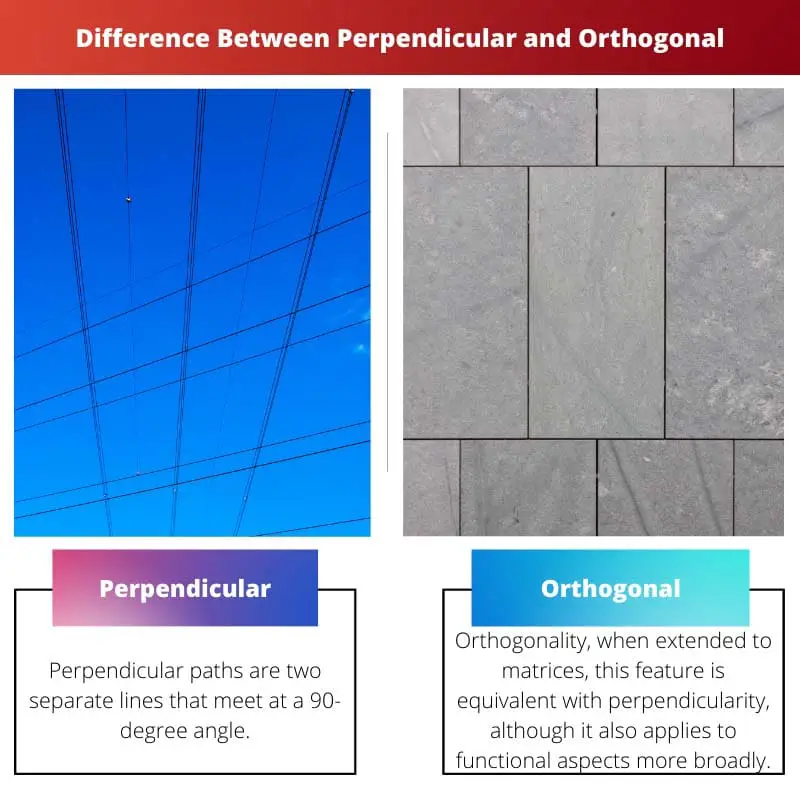When it comes to geometry and mathematics, numerous terms seem to mean the same thing, but that is not the case! The same is the case of a perpendicular pair and an orthogonal figure.
Key Takeaways
- Perpendicular lines intersect at a 90-degree angle, while orthogonal lines or vectors are perpendicular in a multi-dimensional context.
- Perpendicularity refers specifically to lines or planes in geometry, whereas orthogonality applies to more abstract mathematical concepts like vectors and functions.
- Both terms describe a relationship between objects that are mutually independent or unrelated in a spatial or mathematical sense.
Perpendicular vs Orthogonal
Perpendicular is a situation when there are two different lines that meet at the angle 90, and the two lines are dependent while the angle is nonconstant. Orthogonal is a situation where a set of lines are situated at the angle 90, and both of the lines are statistically independent.

They are perpendicular planes, which are straight lines forming two planes that meet at a certain degree – the right angle. “When two planes or lines meet at a 90° angle, we say they are perpendicular.”
The phenomenon of this occurrence and this situation where a right angle is formed while the lines are not parallel to each other is named a perpendicular.
The vector field may include non-zero self-orthogonal variables based on the bilinear form. Groups of properly functioning are used to build a basis for distributed values.
Comparison Table
| Parameters of Comparison | Perpendicular | Orthogonal |
|---|---|---|
| Meaning (Geometric) | Perpendicular paths are two separate lines that meet at a 90-degree angle. | Orthogonality, when extended to matrices, this feature is equivalent to perpendicularity, although it also applies to functional aspects more broadly. |
| Relationship | 1. If two lines meet, one first line is “perpendicular” to the second and vice versa. 2. At the point of incidence, the straight (180) angle on one end of the first line is split into two corresponding angles by the second plane, making them perpendicular and orthogonally positive. | 1. An orthogonal pair’s property and functional aspect is similar to a perpendicular. 2. The dot product of two vector components of an orthogonal pair is zero. |
| Statistical Relation | The two lines are statistically dependent, and the angles are non-constant if either is changed. | The two components of an orthogonal pair are statistically independent of each other. |
| Terminology | Logical and geometric terminology. | Mathematical and geometrical terminology with regards to vector physics. |
| Etymology | The old French and Latin word ‘perpendicularis’ means vertical to the plane. | Late 16th century: from French, based on Greek orthogōnios ‘right-angled’. |
What is Perpendicular?
When two lines or planes cross at a right angle forming angle, the two lines are seen as being perpendicular to each other.
As a result, we may refer to two planes and lines as perpendicular (to each other) without mentioning their sequence.
All crossing planes or lines are perpendicular to each other, but not all meeting lines are perpendicular to one another. Perpendicular lines have two primary characteristics:
- Lines that are perpendicular to one other meet or cross.
- Any angle formed by two line segments that are claimed to be perpendicular is always 90 degrees.
Do not confuse perpendiculars with “parallels”, as they are two straight lines that are separated from one other and never intersect, regardless of how far on either side they are. However, perpendicular, even if stretched to infinity, always intersect or rather “cross” each other.
The symbol represents two perpendicular lines: ⊥.
What is Orthogonal?
Orthogonality, when extended to matrices, this feature is equivalent to perpendicularity, although it also applies to functional aspects more broadly.
An inner product structure may be produced from a concatenation of the components of a set of perpendicular vectors or functions, which means that any component of the space can be generated from the members of such a set.
When the partial derivative is a vector, the dot product (see vector operations); for functions, the definite integral of their multiplication—is 0, and two components of an n-dimensional space are always orthogonal.
An inner product structure may be produced from a concatenation of the components of a set of perpendicular vectors or functions, which means that any component of the space can be generated from the members of such a set.
Main Differences Between Perpendicular and Orthogonal
- Perpendicular also means vertical position, whereas other meanings of orthogonal include; “of two or more conditions in a single problem”.
- Perpendicular is more suitable for describing an object’s positioning, whereas the “orthogonal” term is used to prove the same condition mathematically.


A thorough comparison table has been provided, making it easy to comprehend the differences between perpendicular and orthogonal. I appreciate the emphasis on the meaning and relationship of these concepts to provide a comprehensive understanding.
The article thoroughly explains the meanings and key takeaways of perpendicular and orthogonal in geometry and mathematics. The references provided offer additional support and ensure the credibility of the information. An excellent resource for anyone seeking to understand these concepts.
The comparison table helps in highlighting the differences between perpendicular and orthogonal, including their statistical relations and terminologies. The article offers a complete and thorough understanding of these mathematical concepts, and the references validate the content.
The detailed explanation of the meanings and statistical relations of perpendicular and orthogonal lines is impressive. The article effectively discusses the mathematical and geometric terminologies associated with these concepts, providing a great deal of information.
The article excellently explains the differences between perpendicular and orthogonal lines or vectors in geometry and mathematics, including their statistical relations and the mathematical and geometrical terminology associated with them. I found it particularly insightful to understand the main differences between perpendicular and orthogonal.
The article provides clear definitions of what it means for lines to be perpendicular or orthogonal to each other. The explanation of the terminology, etymology, and main differences between perpendicular and orthogonal helps in gaining a comprehensive understanding of these concepts.
The detailed explanations of what is perpendicular and what is orthogonal provides a comprehensive understanding of the concepts. The mathematical and geometrical terminologies and the main differences between them are well elucidated, making the article informative and insightful.
The article correctly points out that while perpendicularity refers specifically to lines or planes in geometry, orthogonality applies to more abstract mathematical concepts, such as vectors and functions. This distinction was elaborated well, and the explanation is very clear.